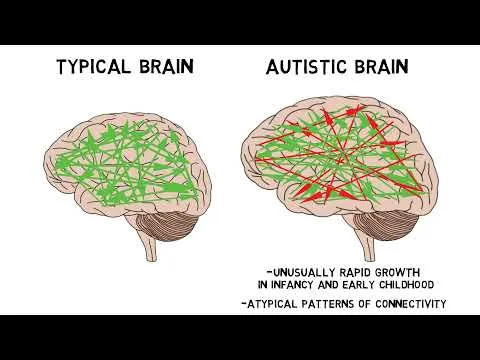
2-Minute Neuroscience: Autism 
Get a comprehesive understanding of 2-Minute Neuroscience: Autism. This is a free course from Youtube. AZ Class provides this course data for free. Learn more certificate and details here. Discover the fascinating world of autism in just 2 minutes! This concise and informative course delves into the neuroscience behind autism spectrum disorder, exploring the potential factors and mechanisms involved in its development. Gain insights into the atypical brain organization and accelerated brain growth experienced by individuals with autism. Uncover the links between alterations in brain circuitry and the onset of autism symptoms. Explore the complex interplay between genetics and environmental factors, and how they may contribute to the risk of autism. Join this course to deepen your understanding of autism and its underlying neuroscience. ▼
ADVERTISEMENT
Course Feature
![]() Cost:
Cost:
Free
![]() Provider:
Provider:
Youtube
![]() Certificate:
Certificate:
No Information
![]() Language:
Language:
English
![]() Start Date:
Start Date:
2021-12-20 00:00:00
Course Overview
❗The content presented here is sourced directly from Youtube platform. For comprehensive course details, including enrollment information, simply click on the 'Go to class' link on our website.
Updated in [October 07th, 2023]
Autism is characterized by impairments in social communication and interaction and restricted and repetitive behaviors. In this video, I discuss the neuroscience of autism along with potential factors and mechanisms involved in the development of autism. TRANSCRIPT: Autism, also known as autism spectrum disorder, is characterized by symptoms that include impairments in social communication and interaction and restricted and repetitive behaviors. Although the neuroscience of autism is still poorly understood, autism is considered to be a complex developmental disorder that involves atypical brain organization starting early in development. Individuals with autism often experience a period of unusually rapid brain growth in infancy and early childhood. This accelerated brain growth is linked to an atypical pattern of connectivity between brain regions. A number of studies report that alterations in brain circuitry involved with social interaction and attention can be detected well before the symptoms of autism begin to appear. At this point, however, it’s unclear how brain overgrowth and atypical connectivity might be linked to the occurrence of autism symptoms. Research suggests that the risk of autism is strongly influenced by genetics, yet studies consistently report that environmental factors also play a large role. Although a number of potential environmental factors have been identified, the risk factors for autism are far from definitive, and it remains unclear which factors are responsible for causing an increase in autism risk, and which are associated in a non-causal way. The risk factors that are most strongly linked to autism are associated with the prenatal or perinatal period. Thus, it’s possible they might be responsible for disruptions to typical neural development, leading to symptoms of autism months or years later. How these risk factors might interfere with neural development is still uncertain, but hypotheses have suggested potential mechanisms such as epigenetic effects, inflammation, oxidative stress, or damage caused by oxygen deficiency. More work needs to be done, however, to fully elucidate the genetic and environmental risk factors for autism, as well as the mechanisms for the development of autism symptoms. REFERENCES: Lord C, Brugha TS, Charman T, Cusack J, Dumas G, Frazier T, Jones EJH, Jones RM, Pickles A, State MW, Taylor JL, Veenstra-VanderWeele J. Autism spectrum disorder. Nat Rev Dis Primers. 2020 Jan 16;6(1):5. doi: 10.1038/s41572-019-0138-4. PMID: 31949163. Lord C, Elsabbagh M, Baird G, Veenstra-Vanderweele J. Autism spectrum disorder. Lancet. 2018 Aug 11;392(10146):508-520. doi: 10.1016/S0140-6736(18)31129-2. Epub 2018 Aug 2. PMID: 30078460; PMCID: PMC7398158. Modabbernia A, Velthorst E, Reichenberg A. Environmental risk factors for autism: an evidence-based review of systematic reviews and meta-analyses. Mol Autism. 2017 Mar 17;8:13. doi: 10.1186/s13229-017-0121-4. PMID: 28331572; PMCID: PMC5356236. Muhle RA, Reed HE, Stratigos KA, Veenstra-VanderWeele J. The Emerging Clinical Neuroscience of Autism Spectrum Disorder: A Review. JAMA Psychiatry. 2018 May 1;75(5):514-523. doi: 10.1001/jamapsychiatry.2017.4685. PMID: 29590280.
Course Provider

Provider Youtube's Stats at AZClass
We considered the value of this course from many aspects, and finally summarized it for you from two aspects: skills and knowledge, and the people who benefit from it:
(Please note that our content is optimized through artificial intelligence tools and carefully reviewed by our editorial staff.)
What skills and knowledge will you acquire during this course?
During this course, you will acquire the following skills and knowledge:
1. Understanding the characteristics of autism spectrum disorder, including impairments in social communication and interaction, as well as restricted and repetitive behaviors.
2. Knowledge of the neuroscience of autism, including the atypical brain organization that occurs early in development.
3. Awareness of the period of accelerated brain growth in infancy and early childhood that is linked to autism.
4. Understanding the alterations in brain circuitry involved in social interaction and attention that can be detected before the onset of autism symptoms.
5. Knowledge of the strong influence of genetics on autism risk, as well as the role of environmental factors.
6. Familiarity with potential environmental risk factors for autism, particularly those associated with the prenatal or perinatal period.
7. Understanding the potential mechanisms by which risk factors might interfere with neural development, such as epigenetic effects, inflammation, oxidative stress, or oxygen deficiency.
8. Awareness of the need for further research to fully elucidate the genetic and environmental risk factors for autism and the mechanisms underlying the development of autism symptoms.
References:
1. Lord C, Brugha TS, Charman T, Cusack J, Dumas G, Frazier T, Jones EJH, Jones RM, Pickles A, State MW, Taylor JL, Veenstra-VanderWeele J. Autism spectrum disorder. Nat Rev Dis Primers. 2020 Jan 16;6(1):5.
2. Lord C, Elsabbagh M, Baird G, Veenstra-Vanderweele J. Autism spectrum disorder. Lancet. 2018 Aug 11;392(10146):508-520.
3. Modabbernia A, Velthorst E, Reichenberg A. Environmental risk factors for autism: an evidence-based review of systematic reviews and meta-analyses. Mol Autism. 2017 Mar 17;8:13.
4. Muhle RA, Reed HE, Stratigos KA, Veenstra-VanderWeele J. The Emerging Clinical Neuroscience of Autism Spectrum Disorder: A Review. JAMA Psychiatry. 2018 May 1;75(5):514-523.
Who will benefit from this course?
This course on 2-Minute Neuroscience: Autism will benefit individuals who are interested in understanding the neuroscience behind autism spectrum disorder. It will be particularly useful for professionals in the fields of psychology, neuroscience, and education who work with individuals with autism or conduct research in this area. Additionally, healthcare professionals, such as doctors and therapists, who provide support and treatment for individuals with autism can benefit from gaining a deeper understanding of the underlying neurological mechanisms involved in the disorder. Parents and caregivers of individuals with autism may also find this course helpful in understanding the neurological basis of the condition and how it may impact their loved ones.
Discussion and Reviews
0.0 (Based on 0 reviews)
Explore Similar Online Courses

Learn All WH questions in Pashto - English to Pashto Learning

Class 1 Full English Course From basic To Intermediate Level In Pashto #englishinpashto

Python for Informatics: Exploring Information

Social Network Analysis

Introduction to Systematic Review and Meta-Analysis

The Analytics Edge

DCO042 - Python For Informatics

Causal Diagrams: Draw Your Assumptions Before Your Conclusions

Whole genome sequencing of bacterial genomes - tools and applications

Understanding Child Language Disorders

Autism at Work - Managing Autism in The Workplace


Start your review of 2-Minute Neuroscience: Autism